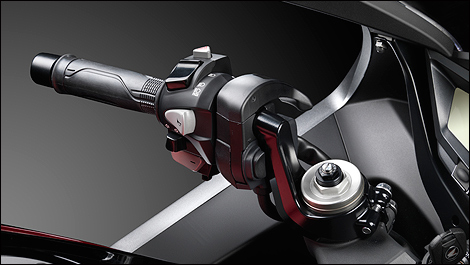We’ve already briefed you about the completely-redesigned
2010 Honda VFR1200, a revolutionary successor to the iconic
VFR800, after our first ride with the machine last October.
At the time, Honda also announced an optional all-new fully automatic Dual Clutch Transmission (DCT). I recently got to sample this technological marvel on a track near Toronto, on a freezing and windy day. Fortunately, the new VFR isn’t a wimp…
Honda’s DCT consists in a pair of manual gearboxes judiciously crammed in a single case, with common torque entry and exit points. Each gearbox uses its own compact multi-plate clutch, one each for odd and even gears. Clutch operations and gear changes are handled by motors and electrical relays under the watchful eye of the ECU, under the command of the fly-by-wire throttle.
The rider can select from two fully-automatic modes, Standard Drive and Sport, and a 6-speed manual mode that shifts gears based on rider input through paddle-style shifters.
 |
| You can make out the pinkish upshift toggle (in manual mode) where your thump can actuate it, with the downshift toggle opposite and actuated by the index finger. The hand brake is actuated by the toggle just above the red handlebar extension. Photo: Bill Petro |
In automatic mode, the rider engages the first gear to take off, and the ECU pre-engages second gear in the other box to transfer power seamlessly when the ECU decides to shift gears (Or when the rider pushes the upshift toggle in Manual mode). The ECU then pre-engages the next gear and so on. It also takes care of downshifting and getting back to first at idle (even in manual mode).
A solution looking for a problem?
Do motorcyclists really need an automatic transmission? Car drivers asked themselves the same question many years ago, not just with regard to the automatic gearboxes, but also about disc brakes, radial tires and ABS. As usual, my initial reaction was one of slight reluctance, born from concern that I would lose direct control over the engine. In fact, the more I spent time on the bike, the more reassured I became.
My boss, Marc Cantin, was right about the VFR’s engine dynamics and behavior during his test-rides last year and in Georgia this March. It isn’t a full-flooded sportbike, but 170 ponies go a long way towards making you forget that it weighs 278 kilos (68 kilos heavier than a
CBR1000RR!). The VFR launched with authority and clawed its way up to over 240kph on the uphill back straight at Mosport. Braking down to 160 for corner 8 was easy, with two finger pull for me but single finger for riders with a stronger hand.
With me neatly tucked behind the generous fairing (At 70kg, I’m on the slim side!), the VFR displayed unruffled poise and stability at top speeds, despite some serious crosswinds.It leans over easily as you enter corners and maintains its trajectory with virtually no assistance. You do have to work a little to change that line while at an angle, which is understandable given the weight of the machine. Overall, though, this Honda feels like a track-ready two-wheel limousine… especially with those wonderful heated grips.

